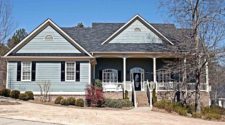The Breakdown
Pros
Cons
Last year, Jim Brown and other home builders around Atlanta could get a good framing crew at a rate of $3.25 per square foot. This year, the few framers they can find demand, and get, almost double that.
“They can ask anything,” Brown said. “There aren’t enough of them left.”
A high-end home builder who supported President Donald Trump last year, Brown said the president’s immigration policies have dried up the already stretched supply of Hispanic-dominated framing labor. That has driven up home prices by slowing the supply of new houses as well as raising the cost of building them. A 3,000-square-foot house that cost $9,750 to frame even late last year now costs $18,000, he said, while last year’s six-month supply of homes in the construction pipeline is down by half. And that’s even before Trump pursues promised trade rule changes that could drive up other home building costs.

Welcome to the America First version of the American home.
Since taking office, Trump has rousted illegal immigrants, overseeing a 145 percent jump in the arrest of noncriminal undocumented workers, and backed plans to squeeze legal ones by letting only English speakers in. He threatened Mexican President Enrique Pena Nieto with a 35 percent tax on the country’s exports to the U.S., raised duties on imported Canadian lumber and continues to rattle China, South Korea and other parts of Asia with tough trade talk. All carry costs for the new U.S. home, a global melting pot of labor and parts. Trump’s policies could add tens of thousands of dollars to the cost of a house.
Start with the framers. They’re now the scarcest labor in the construction business, according to preliminary results of a July survey by the National Association of Home Builders in Washington. Seventy-seven percent of builders reported a shortage of directly hired framing labor, and 85 percent a shortage of framing subcontractors, an increase of 13 and 9 percent, respectively, from last July.
The dearth of framers is part of a national shortage of construction workers that dates back to the recession. It’s gotten worse under Trump, because framing has one of the highest concentrations of immigrant Hispanics in the industry, said Mark Boud, a California-based chief economist for Metrostudy, which provides intelligence to the U.S. real estate industry.

“It’s been especially potent this year because of the ongoing policy changes having to do with immigration,” he said. “We expect costs to continue to rise and that this will not slow down next year, as new immigration policies are approved and implemented.” Those policies include a congressional proposal backed by Trump that would cut legal immigration nearly in half and limit those allowed in to English speakers.
“Immigrants who don’t speak English—that is the framing industry,” Boud said.
Move on to lumber.
More than one-third of the lumber in the U.S. is Canadian. In April and June, in the latest salvo in a long-running trade war, the Trump administration added tariffs totaling nearly 27 percent on Canadian lumber. The move will increase lumber prices, add $1,701 to the price of the average single-family home and may already be reducing supply, according to a series of NAHB reports.
Builders who are struggling to find framers are now also seeing shortages of framing lumber: An NAHB survey published in July found more builders reporting framing lumber shortages than at any time since 2004, when the number of housing starts was almost twice as high.
Then there’s hardware, flooring, steel molded doors, windows and what builders call “finishings,” the lighting, wall covering, fireplaces, countertops, appliances and other bells and whistles that go into a U.S. home. Nearly $11 billion worth of electrical equipment and household appliance imports were used in residential construction in 2015, according to the NAHB, which said even a 10 percent duty on those imports would raise the price of a home another $1,000.

So what would it cost if home builders didn’t use imports?
Taylor Morrison Homes, based in Scottsdale, Arizona, builds homes in seven states and provided Bloomberg with a list of components and their origins for homes in a development called Suwanee Green in the suburbs of Atlanta. A 3,200-plus-square-foot, four-bedroom home there, listed at $385,000 on the company’s website, is neither the cheapest in the market nor the priciest.
The home’s framing lumber comes from Canada. Its nails come from China, which supplies most of the nails in all U.S. homes. The U.S. wood in its cabinet doors are held together with Asian hinges. A U.S.-made front door has a Mexican doorknob and a Chinese lock. Toilet bowls are Chinese, sometimes assembled in Mexico.
Overhead lights are Chinese. The air conditioning and heating systems are made in the U.S. and Saltillo, Mexico, and parts of China, and the microwave ovens from across Asia. The kitchen exhaust fan is from Mexico. The granite countertops are mostly from Brazil.

Add up the prices for the Suwanee Green home’s imported parts—multiplied by how many are in each home—and the cost is nearly $15,000 less than if the same items came from domestic suppliers, according to a Bloomberg comparison. The analysis used import prices from big-box building stores, which are likely higher than what Taylor Morrison pays. It also excluded U.S. products with foreign parts or ingredients like steel, and didn’t account for the limited U.S. supplies of some components and the pressure that would put on price. Some U.S. makers of home finishings also now focus on the highest-end part of the market.
The $15,000 is in addition to the $8,000-plus additional costs for framing labor reported by Atlanta builders.
The best news for home buyers: Trump’s trade policies are unlikely to deliver a hit that high.
Granite countertops come mostly from Brazil, for instance, because the slabs are 70 percent cheaper than U.S. granite and prettier, said Leo Chuahy of Stone Center near Atlanta: “It would take a pretty big duty to really impact that at all,” he said.

For most home components, it would be cheaper for U.S. builders to pay and pass along even the highest punitive tariff Trump has floated to date, than it would be to swap out its imported parts for domestic ones.
A 40 percent tariff on the cost of the Suwanee Green home’s imported parts would add only $7,000 to the cost of the home, less than half the cost of switching the supply chain.
The price of the home would rise, in other words, with little to no effect on American jobs.





